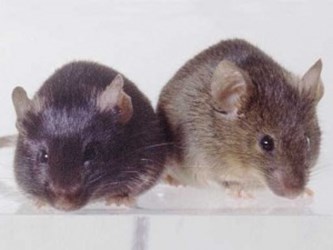Mice With 3D-Printed Ovaries Give Birth To Live Young

Mice implanted with 3D-printed prosthetic ovaries have successfully given birth to live young, said scientists from Northwestern University. According to the researchers, the process is scalable for humans and could one day restore fertility to cancer survivors and women born with reduced ovarian function.
Fertility loss is a significant quality-of-life concern for women diagnosed with cancer. A survey of 657 breast cancer patients under the age of 45 found that 57 percent were concerned about loss of fertility, and 29 percent said that the concern would influence their approach to treatment. Researchers from Northwestern estimate that between 33 and 76 percent of women who’ve undergone cancer therapy have stopped menstruating.
“One of the biggest concerns for patients diagnosed with cancer is how the treatment may affect their fertility and hormone health,” said Monica Laronda, postdoctoral research fellow at Northwestern University’s Feinberg School of Medicine, in a press release. “We are developing new ways to restore their quality of life by engineering ovary bioprosthesis implants.”
Laronda recently presented her team’s findings at the Endocrine Society’s annual meeting. Using a 3D printer, researchers build a scaffold made from biocompatible gelatin, which is robust enough to be handled during surgery, but flexible enough to provide space for hormone-producing cells, immature egg cells (oocytes), and blood vessels to grow.
When researchers replaced the ovaries of mice with the engineered prosthetic, they found that the mice’s female hormone cycle remained intact. The mice were able to give birth to healthy pups and to nurse them.
“We developed this implant with downstream human applications in mind, as it is made through a scalable 3D printing method, using a material already used in humans,” said Laronda. “We hope to one day restore fertility and hormone function in women who suffer from the side effects of cancer treatments or who were born with reduced ovarian function.”
The 3D technology is based on the team’s previous research published in Biomaterials, where they were able to decellularize the ovaries of cows and mice, and recellularize the “organ skeleton” with healthy ovarian follicles to restore a healthy hormone cycle. That process successfully initiated puberty in mice.
Researchers commented in an earlier press release that a healthy hormone cycle provides benefits beyond the ability to bear children, and ovarian dysfunction can affect the “homestasis of systems from bones to neurons.” Laronda hopes that the research from these studies provides a “way to restart the conversation for this type of reproductive biology research.”
Recent advances in 3D-printing technology and materials science have broken a lot of ground in the effort to produce transplantable “living” tissue made from biomaterials and the patient’s own cells, with hopes of replacing donated organs that are scarce and run the risk of tissue rejection.
A team of Russian scientists recently introduced a prosthetic heart made from electrospun spider silk and stem cells, and researchers from Livermore National Laboratory have successfully printed “living” blood vessels.
